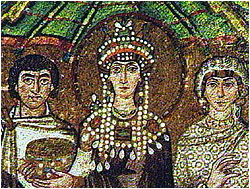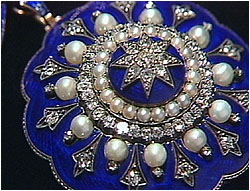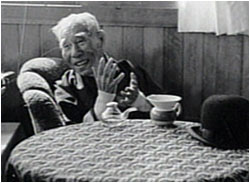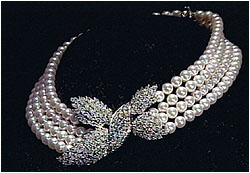
|
 |
 |
© by Fred Ward Long known as the "Queen of Gems," pearls possess a history and allure far beyond what today's wearer may recognize. Throughout much of recorded history, a natural pearl necklace comprised of matched spheres was a treasure of almost incomparable value, in fact the most expensive jewelry in the world. Now we see pearls almost as accessories, relatively inexpensive decorations to accompany more costly gemstones. Before the creation of cultured pearls in the early 1900s, natural pearls were so rare and expensive that they were reserved almost exclusively for the noble and very rich. A jewelry item that today's working women might take for granted, a 16-inch strand of perhaps 50 pearls, often costs between $500 and $5,000. At the height of the Roman Empire, when pearl fever reached its peak, the historian Suetonius wrote that the Roman general Vitellius financed an entire military campaign by selling just one of his mother's pearl earrings. No one will ever know who were the earliest people to collect and wear pearls. George Frederick Kunz, whom I like to call America's first gemologist, in his 1908 masterpiece, The Book of the Pearl, states his belief that an ancient fish-eating tribe, perhaps along the coast of India, initially appreciated the shape and lustre of saltwater pearls, which they discovered while opening oysters for food. No matter the origin, a reverence for pearls spread throughout the world over the ensuing millennia. India's sacred books and epic tales abound with pearl references. One legend has the Hindu god Krishna discovering pearls when he plucks the first one from the sea and presents it to his daughter Pandaïa on her wedding day. China's long recorded history also provides ample evidence of the importance of pearls. In the Shu King, a 23rd-century B.C. book, the scribe sniffs that as tribute, a lesser king sent "strings of pearls not quite round." In Egypt, decorative mother-of-pearl was used at least as far back as 4200 B.C., but the use of pearls themselves seems to have been later, perhaps related to the Persian conquest in the fifth century B.C. Rome's pearl craze reached its zenith during the first century B.C. Roman women upholstered couches with pearls and sewed so many into their gowns that they actually walked on their pearl-encrusted hems. Caligula, having made his horse a consul, decorated it with a pearl necklace.
The Arabs have shown the greatest love for pearls. The depth of their affection for pearls is enshrined in the Koran, especially within its description of Paradise, which says: "The stones are pearls and jacinths; the fruits of the trees are pearls and emeralds; and each person admitted to the delights of the celestial kingdom is provided with a tent of pearls, jacinths, and emeralds; is crowned with pearls of incomparable lustre, and is attended by beautiful maidens resembling hidden pearls."
During the long history of pearls, the principal oyster beds lay in the Persian Gulf, along the coasts of India and Ceylon (now Sri Lanka), and in the Red Sea. Chinese pearls came mainly from freshwater rivers and ponds, whereas Japanese pearls were found near the coast in salt water. Nearly all the pearls in commerce originated from those few sources. Over the next millennium only three substantive events altered what appeared to be a very stable pattern. Considering the minimal state of pearling in the United States today, it is impressive that two of the three developments occurred in the New World. As Europe raced to capitalize on what Columbus had stumbled upon, the major powers of the day concentrated on spheres of influence. Spain focused its efforts in Central and South America and the Caribbean. Along both the Atlantic and Pacific coasts of Central America, the Spanish forced slaves to dive for pearls. The English colonizers along North America's Atlantic coast and French explorers to the north and west, all found native Americans wearing pearls, and they discovered freshwater pearls in the Ohio, Mississippi, and Tennessee River basins. So many gems were exported to Europe that the New World quickly gained the appellation "Land of Pearls."
While North America set a new standard for large freshwater pearls, white saltwater pearls from the coasts of Panama and Venezuela competed with pearls from Bahrain, and black saltwater pearls from the Bay of California (in what is now Mexico) provided an alternative to Tahitian blacks. More pearls arrived in Spain than the country's aristocratic market could absorb. As with the emeralds it was mining in Colombia, Spain found ready buyers for its new pearls across Europe and in India. Those pearl supplies continued into the 1800s, until overfishing in Central American waters and in North American streams depleted the beds. Pollution also took its toll as the United States industrialized. Then, toward the end of the last century, the single event that forever reshaped the pearl trade slowly unfolded in the isolated island nation of Japan.
Kokichi Mikimoto, the son of a noodle maker, had a dream and a hard-working wife, Ume. Together they set about to do what no one else had done—entice oysters to produce round pearls on demand. Mikimoto did not know that government biologist Tokichi Nishikawa and carpenter Tatsuhei Mise had each independently discovered the secret of pearl culturing—inserting a piece of oyster epithelial membrane (the lip of mantle tissue) with a nucleus of shell or metal into an oyster's body or mantle causes the tissue to form a pearl sack. That sack then secretes nacre to coat the nucleus, thus creating a pearl. Mise received a 1907 patent for his grafting needle. When Nishikawa applied for a patent for nucleating, he realized that he and Mise had discovered the same thing. In a compromise, the pair signed an agreement uniting their common discovery as the Mise-Nishikawa method, which remains the heart of pearl culturing. Mikimoto had received an 1896 patent for producing hemispherical pearls, or mabes, and a 1908 patent for culturing in mantle tissue. But he could not use the Mise-Nishikawa method without invalidating his own patents. So he altered the patent application to cover a technique to make round pearls in mantle tissue, which was granted in 1916. With this technicality, Mikimoto began an unprecedented expansion, buying rights to the Mise-Niskikawa method and eclipsing those originators of cultured pearls, leaving their names only for history books.
Even though third with his patents and his secrets, Mikimoto revolutionized pearling. Ever the flamboyant showman and promoter, he badgered jewelers and governments to accept his cultured products as pearls. His workers created massive pearl structures, which he displayed at every major international exposition. By mastering the techniques, Mikimoto, then hundreds of other Japanese firms, made pearls available to virtually everyone in the world. Fred Ward is a gemologist and author of the book Pearls (Gem Book Publishers, Bethesda, Maryland, 1998), from which this article was adapted. What's Killing the Oysters | Culture of Freshwater Pearls How Many Pearls? | History of Pearls | Resources Teacher's Guide | Transcript | Site Map | Pearl Home Editor's Picks | Previous Sites | Join Us/E-mail | TV/Web Schedule About NOVA | Teachers | Site Map | Shop | Jobs | Search | To print PBS Online | NOVA Online | WGBH © | Updated November 2000 |
 As this mosaic reveals, pearls have been treasured
for countless centuries.
As this mosaic reveals, pearls have been treasured
for countless centuries.
 The Romans and Egyptians prized pearls above all
other gems.
The Romans and Egyptians prized pearls above all
other gems.
 Over time, a range of pearl styles became available
to royalty and commoners alike.
Over time, a range of pearl styles became available
to royalty and commoners alike.
 Mother-of-pearl, the iridescent coating inside oyster
shells, once formed the foundation of a thriving
button industry in the U.S.
Mother-of-pearl, the iridescent coating inside oyster
shells, once formed the foundation of a thriving
button industry in the U.S.
 Son of a Japanese noodle maker, Kokichi Mikimoto
single-handedly launched the cultured-pearl industry.
Son of a Japanese noodle maker, Kokichi Mikimoto
single-handedly launched the cultured-pearl industry.
 Mikimoto's efforts made pearls in a range of styles
and prices available to consumers worldwide.
Mikimoto's efforts made pearls in a range of styles
and prices available to consumers worldwide.